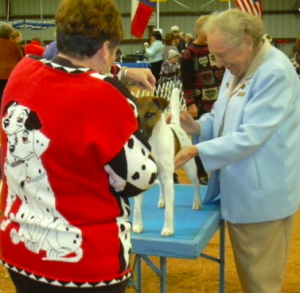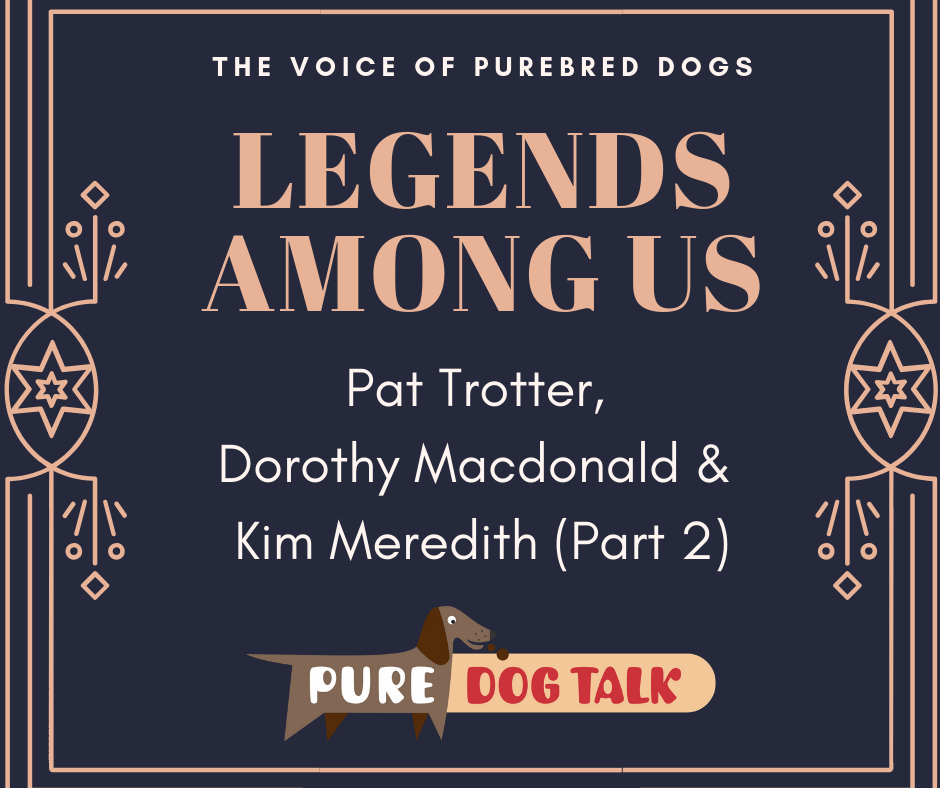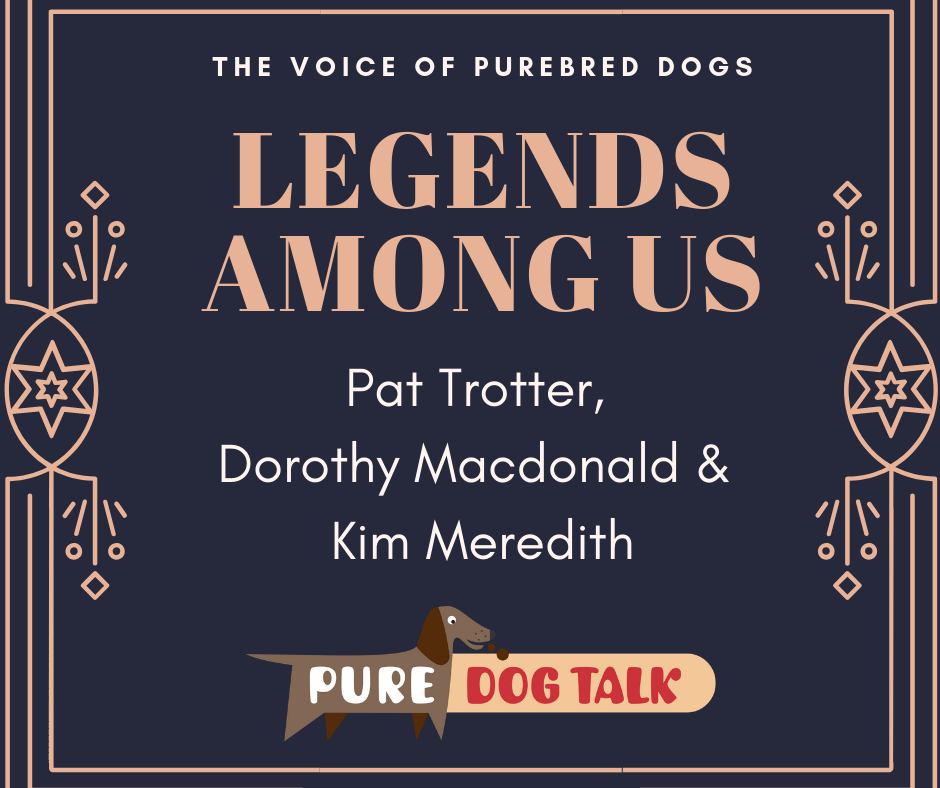590 — Out of the Mouths of Babes: Elliott Wentzel and the Patrons Book Club
Out of the Mouths of Babes: Elliott Wentzel and the Patrons Book Club
Today’s episode is a very special excerpt from our Patrons’ After Dark Book Club. The Patrons community is a fabulous place where folks from all levels of knowledge in the sport come together and form a supportive, open, safe space to discuss all things pure bred dogs.
 Amongst our favorite meetings are our book club conversations where one patron selects a read from the Pure Dog Talk bookshelf and we discuss. In this case, our youngest patron, 18 year old dog show savant Elliott Wenzel, leads the conversation about Pat Trotter’s, iconic “Born to Win, Breed to Succeed” textbook.
Amongst our favorite meetings are our book club conversations where one patron selects a read from the Pure Dog Talk bookshelf and we discuss. In this case, our youngest patron, 18 year old dog show savant Elliott Wenzel, leads the conversation about Pat Trotter’s, iconic “Born to Win, Breed to Succeed” textbook.
Required reading and, frankly, rereading for every purebred dog enthusiast, the book covers in intimate and informed detail a variety of topics central to our sport.
If you two would like to join these uplifting and spirited discussions, join us by visiting Pure dogtalk.com and click the Become a Patron tab at the top of the page. I really hope you enjoyed this brief, fly on the wall, introduction to this very, very special community.
“I had always loved dogs, loved dog shows and I had been watching (my) large collection of Westminster DVD’s,” Wentzel said. “I don’t know, something has always just attracted me to Westminster, you know, with it being the show of shows and all that. And so how can you know Westminster without knowing Pat Trotter, who has won the group 11 times? She’s a big part of it. So I found the book one day, just randomly scrolling through, and I bought it.
“One of the first couple pages of the book (there) was just a quote that I thought spoke volumes about the responsible breeder and what they do in their day-to-day, which was ‘The ethical breeder lives for his dogs, not off of his dogs.’
“And I think that’s just such a valuable statement because I feel like people who look in from the outside think that dogs show people just do it for money, which we all know is not true. I think it’s just such a great statement because it speaks to our motives of why we’re doing this and what we’re doing it for. If we didn’t love the dogs, none of us would be here today.
“One of the other quotes I found from early in on in the book, she said breed specific knowledge must be added to your general knowledge of the dog’s history and origin of your breed, understanding the purpose for which it was bred.
“So when I am looking at dogs I want to know what that dog was bred to do. Because at the end of the day it’s evaluating breeding stock and I just feel like if you don’t know the history of the origin, the purpose of that dog, you’re not gonna gain any of that information about why it’s built the way it’s built.”
298 – Legends part 2: What NOT to do, Too Many Dog Shows
Legends part 2: What NOT to do, Too Many Dog Shows and More
Today’s episode is a continuation of the conversation at the Pure Dog Talk Friday Night Forum at Del Monte Kennel Club in July 2017. Our panel includes Pat Trotter, Dorothy Macdonald and Kimberly Meredith. The conversation continues with questions from social media via live stream and the live audience.
Topics covered include:
- Thoughts on realignment/expansion of groups – realignment to FCI
Kim – hope it never passes – 10 groups in a big cluster would be very difficult – time and costs would be prohibitive
Dorothy – no need to follow fci
- Uncropped dogs in cropped breeds
Kim – doesn’t affect me – don’t pull ears up on uncropped Great Danes.
Dorothy – don’t mind which way they go, just judge them as they are, would prefer no cropping, but have never faulted in judging
Pat – defer to breeder judge – Vince Mulligan
- Decline in entry numbers, too many shows in one weekend… ideas to rein in # of shows &/or bring in more participants
Kim – horse is out of the barn. 200 miles is nothing. AKC approved Too many shows, too close together. It’s a dilemma. Now what do you do? Damage has been done. Show in Chile… FCI subsidizes. AKC approved all the shows… should they supplement these clubs?
Dorothy – the barn door got left open, has evolved… akc will have to rescind licensing. Only solution. They made the mistake, they should bear the solution.
Pat – I think the most innovative person I’ve seen is Kim… what she’s done w/ Woofstock …. Requires more than 2 shows to get the entry up.
- Is the dog that wins BIS the best dog in the show
Kim – whoever’s judging BIS thinks it is
Dorothy – put up the one they thought was best, others might not agree, there are as many opinions as people watching. There are no redos….
Pat – more than one bis when the dog I thought would beat me, didn’t get there.
- Faux pas for exhibitors/what not to do
Kim – very little that irritates me. Except being late. Be there, be prepared, certain breeds are notorious… even if I don’t enjoy them, I enjoy their dogs
Dorothy – excessive roughness from the handler. Pay attention. Keep dog in the shade
Pat – abuse of bait vs use of bait … trying to look at dog’s mouth, shoving bait in its mouth…. Throwing bait… start handling dogs when it stops handling itself… grandstanding… I want to see the dog, not the handler… tendency for handlers to overstretch the dogs… let the judge & steward know if you have multiple dogs & have to change.
296 – Pat Trotter, Dorothy Macdonald and Kim Meredith Speak at Forum
Pat Trotter, Dorothy Macdonald and Kim Meredith Speak at Forum
Today’s episode is part one of a Pure Dog Talk Friday Night Forum at Del Monte Kennel Club in 2017. The panel features Pat Trotter, Dorothy Macdonald and Kim Meredith addressing the topic of the “Judge-Exhibitor Relationship.” Learn about the background and priorities of these legends in the sport.
This Forum was originally available as a livestream video. We’re now bringing everyone all of the information in a three-part series on the podcast.
Topics in this section of the forum include background of the judges, what the judges want to see in the ring, how to ask judges about a dog, the judges’ opinions of the National Owner Handled Series and withholding ribbons.
Learn From the Source
In a current moment that features social media commentary pages on which exhibitors “report” on the judges, often with great vitriol, the value of hearing directly from the judges and what matters to them cannot be overstated.
 A highlight of the conversation is Dorothy Macdonald’s description of coming to the US with her family in 1941 and bringing the dogs they could with them, including a Kerry Blue Terrier rescued from Dunkirk.
A highlight of the conversation is Dorothy Macdonald’s description of coming to the US with her family in 1941 and bringing the dogs they could with them, including a Kerry Blue Terrier rescued from Dunkirk.
Macdonald is noted as one of a handful of judges who judge both conformation and field trials.
“I judged field trials as many years as dog shows,” Macdonald said. “I put up the first English setter running in the field that was a show champion.”
“As long as you’re more interested in the dogs than the people, there will never be a split (between exhibitors and judges),” Macdonald said. “I want an exhibitor to be happy in the ring. I’m interested in the dog, not the exhibitor’s ability. Just need them to control the dog. It’s the dog I want to see.”
“We all had a first time in the ring,” Trotter said. “I do want them to have a dog that’s somewhat prepared for the event. I want to have a dog we can go through the process … see the bite, see the dog move.”
“I’m always happy to talk about the dogs I’ve judged,” Meredith said. “Attitude and how the question is approached are everything.”
177 — Developing An Eye For a Dog: Recorded LIVE
Developing An Eye For a Dog: Recorded LIVE
San Mateo Kennel Club invited PureDogTalk to sponsor a live expert roundtable at its all-breed show in March. Exhibitors who participated were treated to a rare opportunity to interact directly with some of the most knowledgeable people in the sport. Judges Pat Trotter, Desmond Murphy, and Ken Murray were joined by professional handler Andy Linton to address the topic of developing an eye for a dog and answer audience questions.
“Lifers” Share Their Knowledge
These folks are what we think of as “lifers” in dogs. They started young with a passion for dogs and have applied that intensity to achieving their goals as breeders, handlers, and judges. Each and every one of the panelists is a lifelong student, who possesses the noted “eye for a dog” we were discussing.
While each of the panelists brought their own perspective to the conversation, there was complete agreement that developing an eye for a dog entails focusing on and rewarding a dog’s virtues rather than picking at faults. Riffing on a quote from the well-known judge of the ‘60s, Bea Godsol, whom Trotter noted was gifted with a tremendous eye for a dog, the panelists each shared their spin.
Ken Murray – “Great dogs carry their faults well,”
Pat Trotter – “An absence of faults doesn’t guarantee virtue,”
Desi Murphy – “Great dogs blind you to their faults.”
Andy Linton agreed, noting also that, “having an eye for a dog gives you responsibility in so many ways. Do I take that dog to show? Do I put that dog up? Do I breed that dog? The more you know, the more responsible you become.”
“An eye for a dog,” according to Trotter, “is when you see one that gets your attention. It’s an arresting animal because it exudes beauty and correctness. Like a work of art.”
Trotter added wryly, “Sometimes great dogs get lost at shows where they are the right look. They’re different from the other dogs who are, shall we say, modest at best.”
Even if a person isn’t “born with it” in terms of that eye for a dog, Trotter does believe that studying and learning, and listening to the greats in a breed will allow someone to develop the skill.
Murphy qualifies that with an observation that some people are simply better at the skill than others.
“I mean there were certain subjects, if I went to school for 10 years on that subject I would never have been any good,” Murphy observed. “… judges are like dogs. You have excellent, very good, good, satisfactory and unsatisfactory.”
When an audience member asked how to know which judges have an “eye for a dog” and how to discern to whom they should show their “great dog that doesn’t look like the others,” Bill McFadden, speaking up from the gallery, noted we all need “an eye for a judge.”
Trotter summed up much of the advice with this observation, “I think one thing that helps breeders is to look at your own dogs with a jaded eye. Look at them with a jaded eye and see their shortcomings. And look at your competition through rose-colored glasses. That will help you advance in your efforts to become a better evaluator as a breeder and exhibitor.”
Please enjoy this special and valuable conversation. What it may lack in our normal audio quality, it more than makes up for in the quality of the knowledge.
Additional Q&A coverage from this event is available ONLY to our PureDogTalk Patrons! Click the button on our website to “Be My Patron on Podbean” for more information about joining the “in” crowd.
And, making a surprise Thursday appearance, Allison Foley’s Tip of the Week from the Leading Edge Dog Show Academy provides insight on dealing with stains on white dogs.




